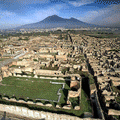
Naples Hotels

Reserve Naples Hotels: save up 70% on rooms!
Compare offers & book on line at hotel's web sites. |
|
|

|
|
|
Naples Guide Italy
Places and charm
|
|
|
|
|
Places and charm
The best way to get to know Naples is to walk around its ancient streets, discovering the hidden wonders of this amazing city:
- SpaccaNapoli – This road is called by this name (it literally means Split Naples) as, when seen from the top end, it literally splits the city into two parts. SpaccaNapoli is a long straight road, or several roads about 2 km long and just 6 meters wide. On both sides a tightly-packed labyrinth of narrow, charming alleys spreads out. This is the old, working-class, full-blooded Naples. Walking along the SpaccaNapoli, it is possible to follow an itinerary in one of the most characteristic areas of Naples, that corresponds to the “Decumano inferiore” of the Greek-Roman city, with churches, historical buildings, squares and old tiny craftsmen’s shops and laboratories.
- Vomero – This is an extremely peaceful, relaxing area of the city just the opposite of SpaccaNapoli. The area is full of museums, monuments, shops and historical coffee shops. A truly unforgettable experience is a trip on the Montesanto cable railway, from where it is possible to have a great view of Castel Sant'Elmo and the Certosa di San Martino.
- Quartieri spagnoli – One of the most fascinating places in the city that has to be explored bit by bit in this tight-knit labyrinth of alleyways and streets. When Spanish rule began around 1530, the city underwent a lot of transformations: churches, palaces and roads were built, including the wonderful Via Toledo, which took its name from the viceroy Don Pedro di Toledo. This is the period when the Quartieri Spagnoli sprung up, in an area that is now bordered by Corso Vittorio Emanuele and Via Toledo and which totals about 800,000 m2.
- Via San Gregorio Armeno – This road is famous worldwide as the "nativity scene road”. In this road, which links the old city center to the main roads, there are some important monuments such as the San Gregorio Armeno Monastery. This is also the city center for hundreds of artists’ and commercial businesses: sculptors, silversmiths, gilders, and many craftsmen that make figurines for nativity scenes, and who still use traditional methods.
- Galleria Umberto I – This gallery was built at the end of the nineteenth century. Galleria Umberto is an imposing building with four wings in iron and glass and a wonderful, huge dome in the middle. The style is similar to that of the Galleria Vittorio Emanuele in Milan.
- Posillipo Hill – This hill, that is part of the sides of a crater, separates the Gulf of Naples from Pozzuoli dalla Grotta Romana. Since ancient times, this area has always been considered a residential area, where it is possible to rest from the efforts of city life. The very name of the area is a demonstration of this: the Greek term Pausilypon means "a respite from pain”. The beautiful villas with their wonderful views over the Gulf can still be admired today, like, for example, the seventeenth century Palazzo Donn Anna.
- Underground Naples – This is a "city under the city” that is exceptionally old: archeological digs have found artifacts dating back 5000 years. The Greeks built imposing funeral monuments underneath the city, while the Romans built aqueducts, caverns and tunnels. The public can now visit some parts of these underground areas if accompanied by a guide.
- Piazza del Plebiscito – This recently renovated square is the most magnificent in Naples: it is built in the form of an amphitheater and is surrounded by wonderful monuments such as the Basilica of San Francesco di Paola, which is similar to St. Peter’s in Rome, the Royal Palace and the Galleria Umberto I.
- Piazza Bellini – This is a spot that is full of life, filled with open-air coffee shops that crowd around the monument built to commemorate the composer of the same name and the archeological site that has brought to light the ancient Greek walls that once stood on the square’s site.
- Piazza del Gesù Nuovo – This square is cut in two by SpaccaNapoli, the famous, ancient road in Naples. There are some of the city’s most important monuments here: Palazzo Pignatelli, the Guglia dell'Immacolata (a huge church spire), the Church of Gesù Nuovo, the Monastery of Santa Chiara.
Go to directories of the Web Sites
Go to the itinerary:
|
|
|
|
|
Acquista la tua visibilità su Travel Plan
|
|
|
|





